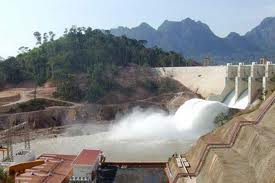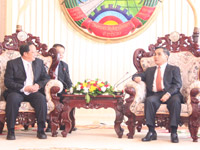Low prices mean struggles for Vientiane fish farms
Low prices mean struggles for Vientiane fish farms
Vientiane fish farms are being more adversely affected by low prices than by the customary numbers of fish that die in the nets due to the high level and poor quality of the Mekong River water in the rainy season.
The fish price direct from the farms is around 13,000 kip a kg, while at the market it remains stable at 18,000-20,000 kip, the Lao fish farm breeding group President, Mr Kenchan Thailavan told Vientiane Times on Friday.
“The price of farmed fish in Vientiane is low due to the competition from unlicenced foreign breeders, who can sell their fish at a cheaper price because they have the resources to force down the price and drive out competition,” he said.
“Most of them are breeding along the Nam Ngum River of Xaythany district,” said Mr Kenchan.
The government, espe-cially through the Vientiane authorities, is encouraging these foreign breeders to register as foreign investors under the Lao fish farm breeding group.
“This will help Lao fish farm breeders especially in Vientiane to become self-sufficient as there would no longer be unfair competition from outside,” he said.
“The low price of 13,000 kip may be good for traders and consumers but it is impossible for breeders to maintain because the cost of fish farming is about 15,400 kip per kg, so breeders not only cannot make a profit but are faced with making a loss on each sale at the moment,” Mr Kenchan said.
Most of the Lao fish farms have borrowed money from banks at quite high interest rates in order to develop their farms as they do not have their own resources.
“Strong competition from foreign breeders in the past caused many fish farms in Vientiane to go out of business, so our group now has only 65 member farmers, around 1,000 nets,” he explained.
He believed that if this problem is not resolved by the government or relevant sectors, Lao breeders will not be able to stay in the business for very long.
They are now waiting for an answer from the government to know whether or not to raise further capital for developing their farms.
“One more challenge for us at the moment is the high level and poor quality of the Mekong River but this is not a big problem for breeders because it is a natural phenomenon,” Mr Kenchan said.
“To protect the fish from natural dangers we carefully monitor the quality and level of river water so that action can be taken when necessary,” he commented.
Some farmers have had to move their stock to a less polluted location and postponed breeding fingerlings until the end of the rainy season to avoid the problem.
The government should closely monitor this situation as it may apply to many small to medium d business activities in the country.
Low prices mean struggles for Vientiane fish farms
Vientiane fish farms are being more adversely affected by low prices than by the customary numbers of fish that die in the nets due to the high level and poor quality of the Mekong River water in the rainy season.
The fish price direct from the farms is around 13,000 kip a kg, while at the market it remains stable at 18,000-20,000 kip, the Lao fish farm breeding group President, Mr Kenchan Thailavan told Vientiane Times on Friday.
“The price of farmed fish in Vientiane is low due to the competition from unlicenced foreign breeders, who can sell their fish at a cheaper price because they have the resources to force down the price and drive out competition,” he said.
“Most of them are breeding along the Nam Ngum River of Xaythany district,” said Mr Kenchan.
The government, espe-cially through the Vientiane authorities, is encouraging these foreign breeders to register as foreign investors under the Lao fish farm breeding group.
“This will help Lao fish farm breeders especially in Vientiane to become self-sufficient as there would no longer be unfair competition from outside,” he said.
“The low price of 13,000 kip may be good for traders and consumers but it is impossible for breeders to maintain because the cost of fish farming is about 15,400 kip per kg, so breeders not only cannot make a profit but are faced with making a loss on each sale at the moment,” Mr Kenchan said.
Most of the Lao fish farms have borrowed money from banks at quite high interest rates in order to develop their farms as they do not have their own resources.
“Strong competition from foreign breeders in the past caused many fish farms in Vientiane to go out of business, so our group now has only 65 member farmers, around 1,000 nets,” he explained.
He believed that if this problem is not resolved by the government or relevant sectors, Lao breeders will not be able to stay in the business for very long.
They are now waiting for an answer from the government to know whether or not to raise further capital for developing their farms.
“One more challenge for us at the moment is the high level and poor quality of the Mekong River but this is not a big problem for breeders because it is a natural phenomenon,” Mr Kenchan said.
“To protect the fish from natural dangers we carefully monitor the quality and level of river water so that action can be taken when necessary,” he commented.
Some farmers have had to move their stock to a less polluted location and postponed breeding fingerlings until the end of the rainy season to avoid the problem.
The government should closely monitor this situation as it may apply to many small to medium d business activities in the country.
vientiane times


















